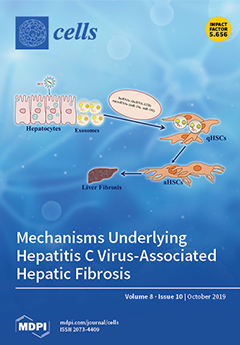Connexin 43 (Cx43) is essential for cardiac electrical coupling, but its effects on myocardial fibrosis is controversial. Here, we analyzed the role of Cx43 in myocardial fibrosis caused by angiotensin II (AngII) using Cx43
fl/fl and Cx43
Cre-ER(T)/fl inducible knock-out (Cx43 content: 50%)
[...] Read more.
Connexin 43 (Cx43) is essential for cardiac electrical coupling, but its effects on myocardial fibrosis is controversial. Here, we analyzed the role of Cx43 in myocardial fibrosis caused by angiotensin II (AngII) using Cx43
fl/fl and Cx43
Cre-ER(T)/fl inducible knock-out (Cx43 content: 50%) mice treated with vehicle or 4-hydroxytamoxifen (4-OHT) to induce a Cre-ER(T)-mediated global deletion of the Cx43 floxed allele. Myocardial collagen content was enhanced by AngII in all groups (n = 8–10/group,
p < 0.05). However, animals with partial Cx43 deficiency (vehicle-treated Cx43
Cre-ER(T)/fl) had a significantly higher AngII-induced collagen accumulation that reverted when treated with 4-OHT, which abolished Cx43 expression. The exaggerated fibrotic response to AngII in partially deficient Cx43
Cre-ER(T)/fl mice was associated with enhanced p38 MAPK activation and was not evident in Cx43 heterozygous (Cx43
+/-) mice. In contrast, normalization of interstitial collagen in 4-OHT-treated Cx43
Cre-ER(T)/fl animals correlated with enhanced MMP-9 activity, IL-6 and NOX2 mRNA expression, and macrophage content, and with reduced α-SMA and SM22α in isolated fibroblasts. In conclusion, our data demonstrates an exaggerated, p38 MAPK-dependent, fibrotic response to AngII in partially deficient Cx43
Cre-ER(T)/fl mice, and a paradoxical normalization of collagen deposition in animals with an almost complete Cx43 ablation, an effect associated with increased MMP-9 activity and inflammatory response and reduced fibroblasts differentiation.
Full article






